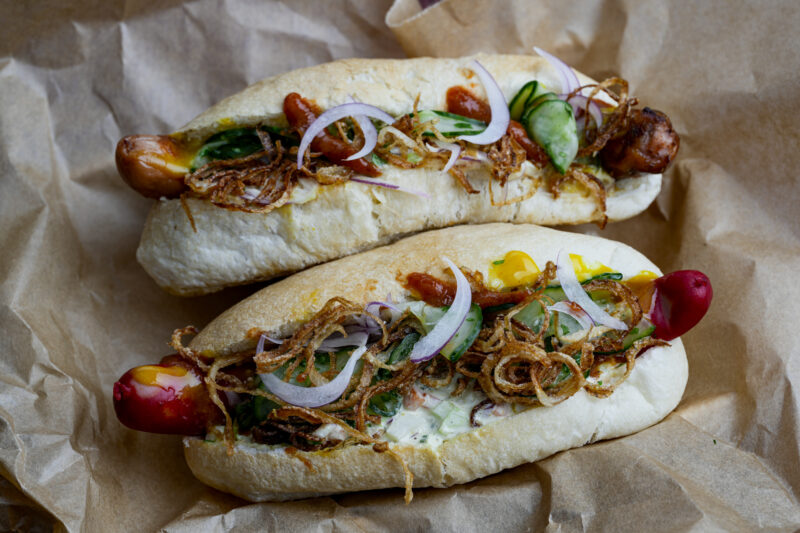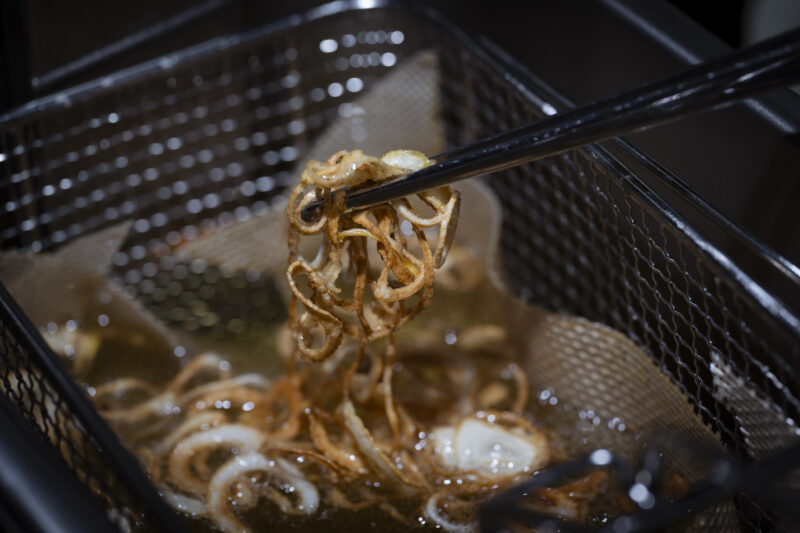There’s something special about Danish hot dogs
Hot dogs are a summertime favorite all over the globe. You eat them while walking through the park, at your favorite sports games, or around a campfire. While sausages have been around for centuries, it was the Germans who are at the basis of the hot dog as we know it today: a sausage on a long bun with a layer of mustard on top. But in Denmark, they do things a little differently. I wanted to find out what makes a Danish hot dog so special.

From the Oddysee to New York
Homer already mentioned delicious goat sausages sizzling on the grill in his epic poem, The Odyssey. That was almost 3,000 years ago. At the same time, Chinese cooks were also preparing sausages with leftover meat, thousands of miles away. This practice of not letting food scraps go to waste has been around for a long time, and sausages are a great way to process and preserve small bits of meat.
Sausages also made their way across Europe and ended up in Germany. The Germans embraced the sausage in all its forms and flavors. Frankfurt says it’s the birthplace of the hot dog, but Vienna also claims that title. What we do know is that the Germans were already eating sausage with bread 500 years ago. This tradition was brought to the New World by German immigrants, who sold their dachshund sausages on bread from handcarts.
But it was Jewish immigrant Nathan Handwerker from Poland who made the hot dog popular in America. He saved up enough money to buy his own hot dog stand and sold his hot dogs at a lower price than his competitors. Nathan's Famous was his trademark, and it became the benchmark for the best hot dogs in America.

Hot dogs are taking over Denmark
Hot dogs were already popular in America and Germany by the end of the 18th century, but it wasn't until 1920 that Denmark had its first hot dog stand. The city authorities in Danish cities were not keen on issuing permits. They were worried that the crowds at the stalls would cause traffic issues. They also felt that eating on the street was not acceptable. But Charles Svendsen Stevns was determined to succeed and was the first to obtain permission to open a hot dog stand in several places in Copenhagen. The Danes were instantly hooked on the sausage sandwich and embraced the hot dog as their new favorite street food.
What makes a Danish hot dog so special?
Danes take hot dogs seriously. They don't just stop at mustard, ketchup, and sauerkraut. The Danes go the extra mile and use ingredients and flavorings typical of local Danish cuisine.

It all starts with the sausage
The key difference between a Danish hot dog and the others is the sausage. In Denmark, they call it pølser. The extra-long sausage is made from pure pork and spices like cardamom and nutmeg. The sausages are made with a natural casing and smoked over beech wood. They come in two versions. The most popular is the røde pølser, a Vienna-style sausage whose casing is colored red with carmine. They're always boiled or poached. Then there's the plain pølser, which has a natural brownish color and is always grilled.
You can buy pølser in Brussels at Nordic Fine Foods, rue Archimède 59, 1000 Brussels.

Remoulade, the Danish sauce par excellence
Then there's the sauce. A Danish hot dog is not a hot dog without remoulade. The traditional sauce is served with everything from smørrebrød, hot dogs, and hamburgers to fried fish and roast beef. The base of the sauce is mayonnaise and sour cream. Plus, it's got a mix of veggies and spices. Typically, remoulade includes carrots, white cabbage, red onion, and pickled cucumber or cucumber salad. You can also enjoy the sauce with capers, red cabbage, celeriac, or dill. There's no set recipe for remoulade. In fact, there are as many versions of it as there are cooks.
The classic Danish hot dog toppings
When you arrive at Copenhagen Airport, you'll find the Danish pølsevogn, the hot dog stand, waiting for you with the typical Danish hot dog. What traditional toppings can you expect? Once you've chosen between a red pølser and a regular pølser, the hot dog will come with sweet or spicy mustard, ketchup, remoulade, raw onion, fried onion, and cucumber. You can choose not to take certain ingredients, but for the full Danish hot dog experience, the all-in version is a must.

Recipe: Classic Danish hot dogs
Ingredients:
For the hot dogs:
- 4 hot dog buns
- 4 Frankfurter sausages or Danish pølser
- 2 tablespoons chopped red onion
- Ketchup
- Sweet or spicy mustard
For the remoulade:
- 1 small carrot
- 2 leaves of white cabbage
- ½ snack cucumber or 1 large pickle
- ¼ red onion
- 1 tablespoon capers
- 1 tablespoon chives
- 1 teaspoon mustard
- ½ teaspoon curry powder
- Juice of ½ lemon
- 100 ml mayonnaise
For the cucumber salad:
- 1 cucumber
- 1 teaspoon of salt
- 100 ml white wine vinegar
- 2 tablespoons of water
- 50 g sugar
- 1 tablespoon finely chopped parsley
For the fried onions:
- 2 onions
- 1 tablespoon of flour
- 1 teaspoon of sea salt
- Oil for deep frying
-
Step 1: First, make the remoulade
Cut the carrot into small cubes and cook them until they're just cooked through but still a little crisp. Next, chop the white cabbage, red onion, and capers and dice the cucumber. Then just combine everything together.
![SG Danish Hotdogs 086]()
-
Step 2: Time to get the cucumber salad ready!
Use a mandolin to slice the cucumber into super-thin slices and sprinkle with salt. Let the cucumber stand for about half an hour. Rinse the slices and pat them dry. Mix the vinegar, water, and sugar together until the sugar is completely dissolved. Now, add the cucumber and parsley to the vinegar mixture and let it chill in the fridge for about 30 minutes.
![SG Danish Hotdogs 148]()
-
Step 3: Deep fry the onions.
Cut the onions into thin rings with a mandolin. Mix the flour with the salt and add the onion rings, coating them in a thin layer of flour. Just shake off the excess flour.
Heat the oil to 170°C and fry the onion rings in small batches until they're golden brown and crispy. Once the onions are fried, drain them on some kitchen paper and sprinkle with a little extra salt.
![SG Danish Hotdogs 5910]()
-
Step 4: Next, make the hot dogs.
You can poach the Frankfurters or grill the Danish pølser. Cut the buns lengthwise halfway through. Then, brush with mustard and ketchup. Put a sausage in each bun and then add some red onion, remoulade, cucumber salad, and fried onion to finish it off.
![SG Danish Hotdogs 330]()
In the mood for something a little more upscale? How about a lobster roll, a luxury street food from the USA?



